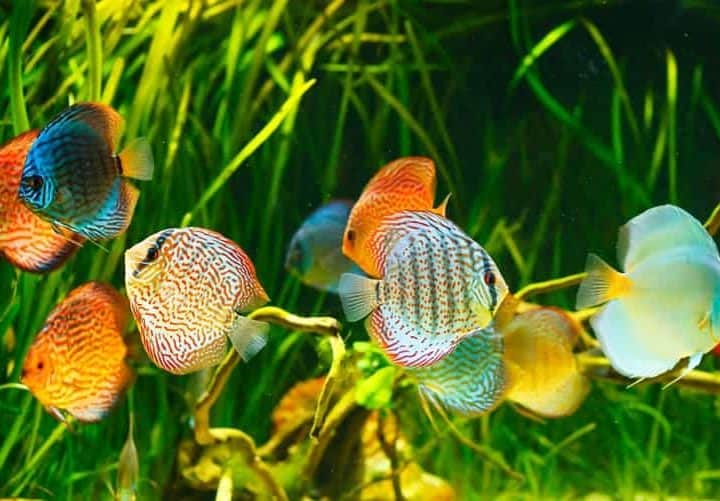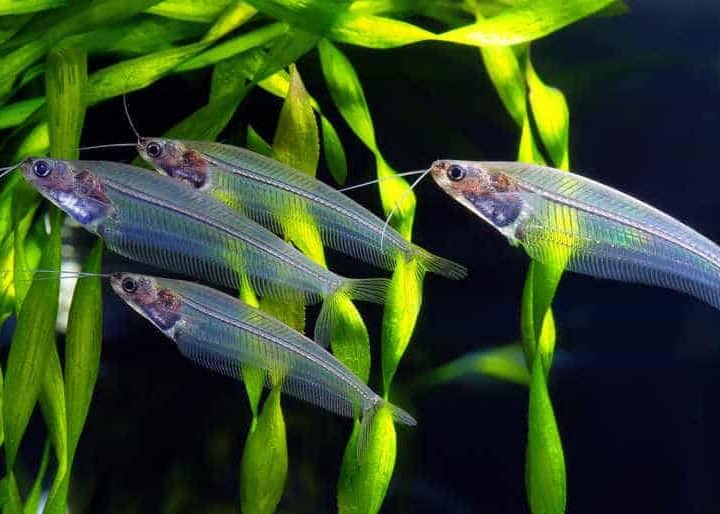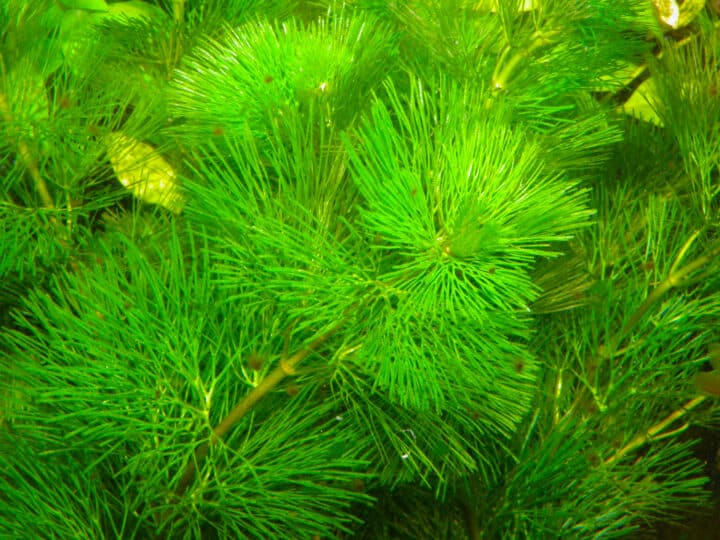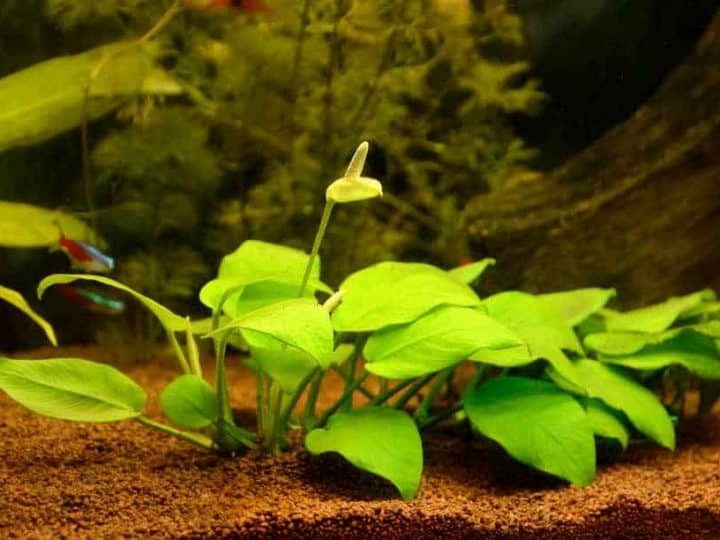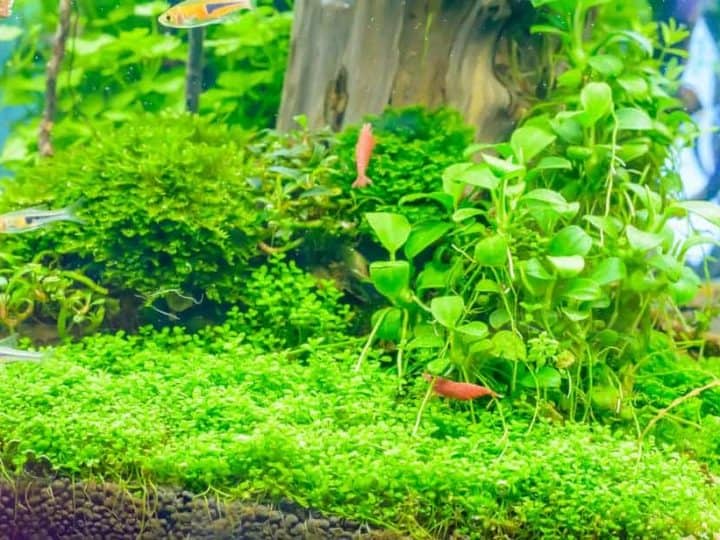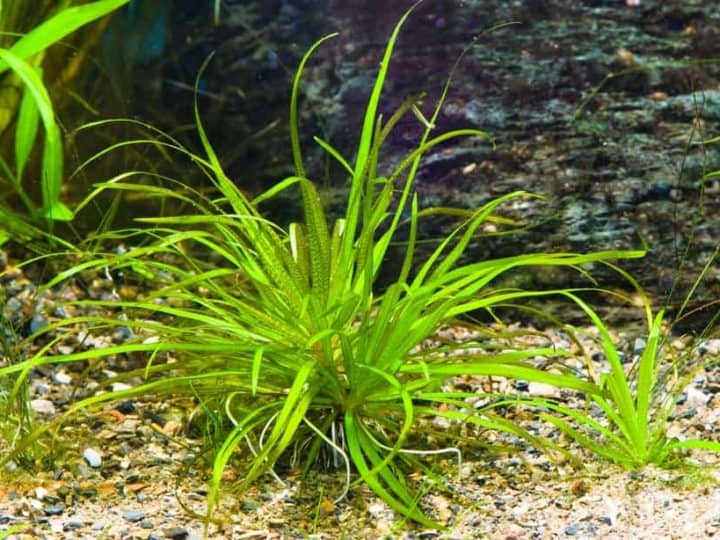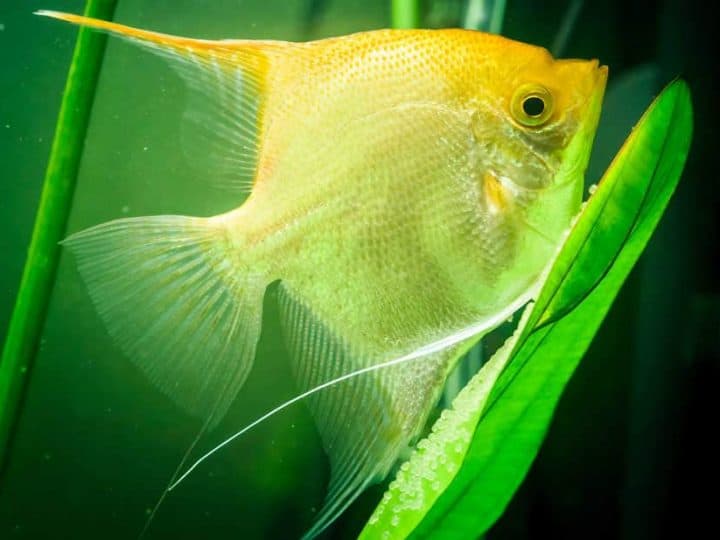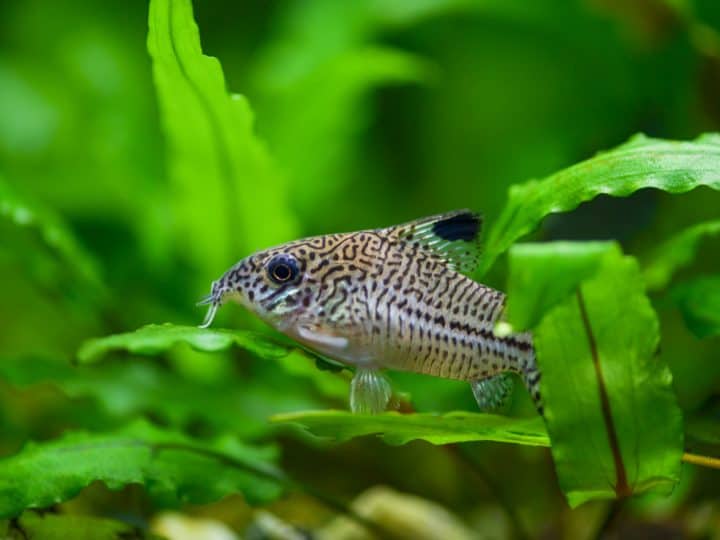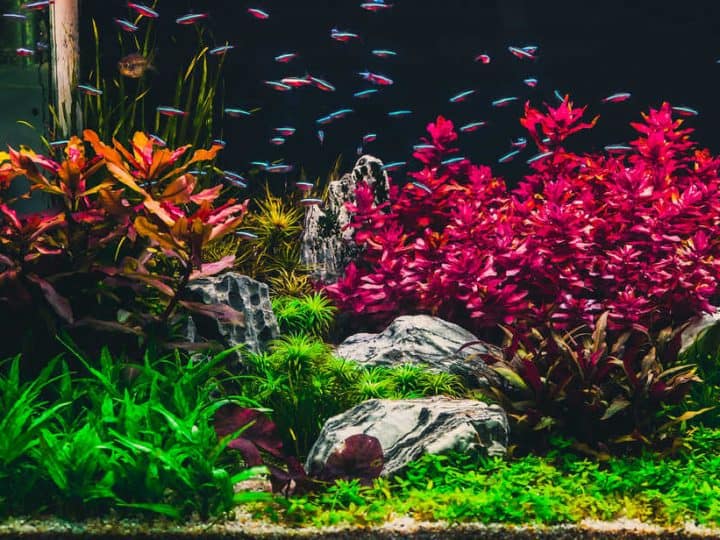You might be wondering whether your tank plants can be grown buried in a gravel substrate. Today, we’re talking about the top 10 aquarium plants that grow in gravel.
Some of the best aquarium plants that grow in gravel include amazon sword, madagascar lace, java fern, red tiger lotus, anubias, vallisneria, and many more!
Lucky for you, I did some research on plants that grow in gravel.
1. Amazon Sword (Echinodorus grisebachii)
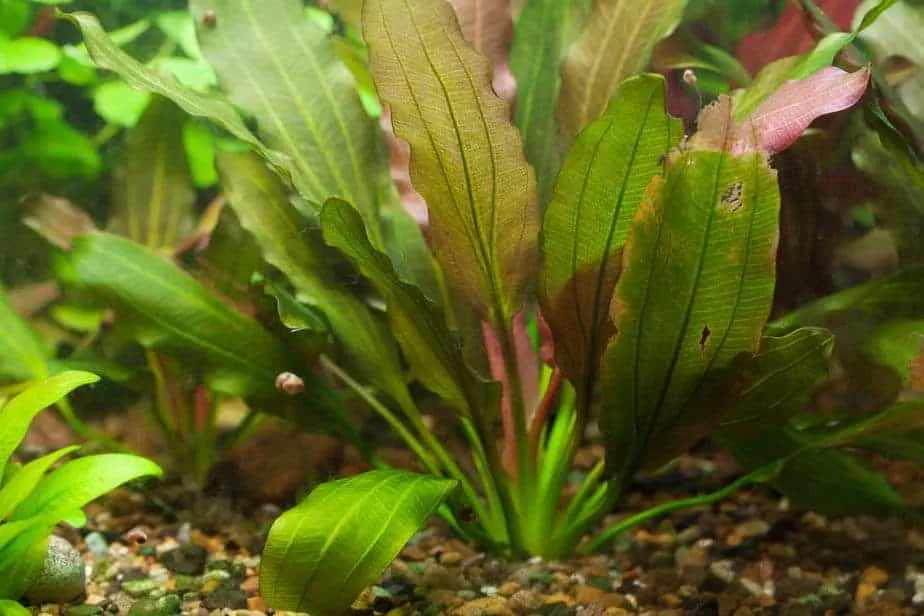
| Common name: | Amazon Sword |
| Scientific name: | Echinodorus grisebachii |
| Max height: | 16 in / 40 cm |
| Care complexity: | Easy |
| Lighting needs: | Medium to High |
| Growth rate: | Moderate |
| Additional CO2 required: | No |
| Recommended position: | Background plant |
| Fertilization: | Root tabs |
| Availability: | Buy on Amazon |
The first gravel plant I will introduce is the Amazon Sword. This is a great starter plant that won’t give beginners a hard time.
It requires moderate levels of light and can survive well in a range of temperatures.
Tip: a lot of these plants are also on my list of great aquatic plants for beginners. If you’re looking for more inspiration, check out the list here.
This plant will look great in your aquarium, and it works well for angelfish tanks too!
It has long sword-like leaves that can be grown in the background of your tank, or it can be placed in the center of your tank alone as a centerpiece.
Just make sure to put enough gravel in your tank to root your plant. You want a little under three inches, around 2.5 inches to be exact, and the gravel should be loosely packed as well.
Give them space to grow because they will get big!
Also, make sure to provide enough nutrients by adding root tabs on a regular basis. Once every three months should suffice.
Before we move to the next plant, I must tell you a bit more on taking care of plants. If you don’t know how to add the right type of fertilizer for example, your plants will slowly die after adding them to your tank.
How to Feed Aquarium Plants in Gravel
Plain gravel contains no nutrients for your plants, at least not when it’s new and straight out of the bag. This is something you should take into account.
I really recommend adding some form of plant fertilizer to your tank.
The easiest way to feed plants is by adding liquid plant fertilizer. This is something that you add once a week. It allows your plants to suck food straight out of the water.
Although your fish do produce some plants food (poop), it’s not enough to provide for your plants.
The liquid fertilizer that I have been recommending for years is from the brand API which they call Leaf Zone. It’s an all-in-one plant fertilizer that will not let you down. Check it out here on Amazon.
Other options are changing to aquarium soil instead of gravel, which is expensive and, in my opinion, not worth it.
You can also add root tabs. Root tabs are tablets that contain nutrients. Simply push them down in the gravel near the roots of your plant. I only add root tabs to heavy root feeding plants.
I did a thorough comparison between different types of root tabs. You can find that article here on my website.
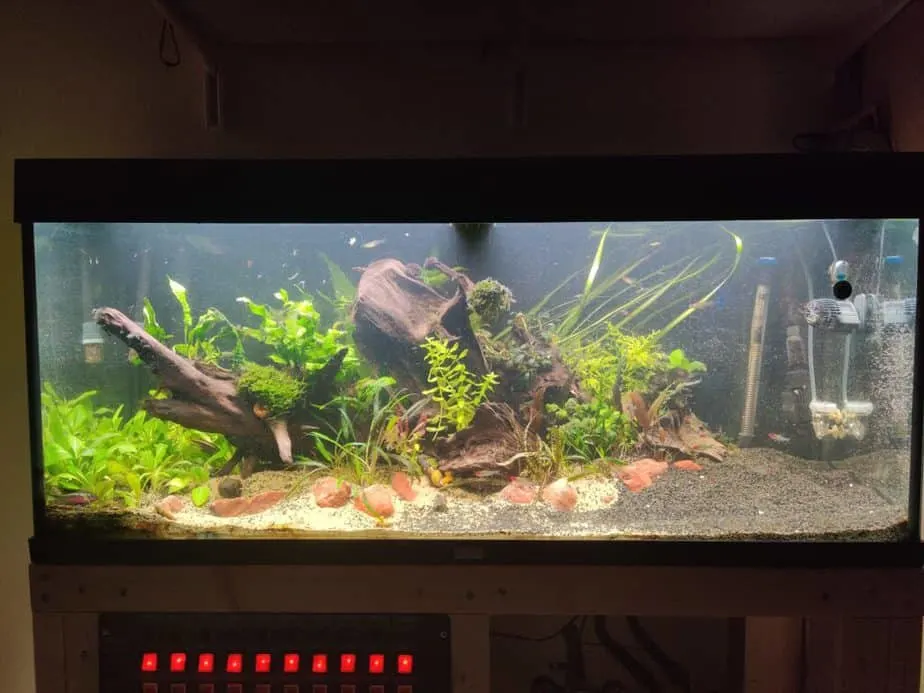
To my tank, which you can see on the picture, I add liquid fertilizer on a weekly basis. For the plants that need root tabs, such as Amazon swords, I regularly add new root tabs. I try to push a new root tab in the gravel near the roots every 3 months.
Let’s move to the next plant on the list!
2. Madagascar Lace (aponogeton madagascariensis)
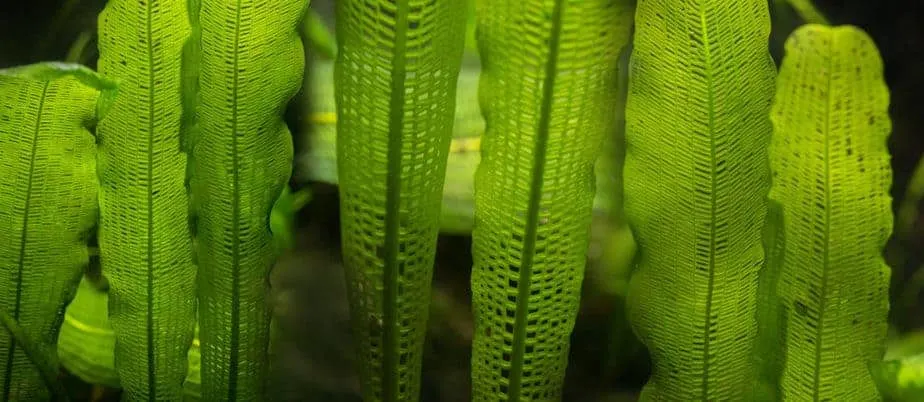
| Common name: | Madagascar Lace |
| Scientific name: | Aponogeton Madagascariensis |
| Max height: | 8 in / 20 cm |
| Care complexity: | Easy |
| Lighting needs: | Low to Moderate |
| Growth rate: | Slow to Moderate |
| Additional CO2 required: | No |
| Recommended position: | Midground plant |
| Fertilization: | Root tabs |
| Availability: | Buy on Amazon |
Madagascar Lace can grow well in gravel as well, but it isn’t a simple plant to care for. You will need to make sure your plant has the right conditions to accommodate its growth.
Water temperature can be on the colder side, around 60 to 70 degrees Fahrenheit. Light requirements are medium to high for this plant.
More light will let your plant grow faster, so I recommend using higher levels of light. Still, the light intensity is up to you. It’s a plant that enthusiasts like because it can survive in low light conditions, making it one of the most popular plants around for anyone with an aquarium hobby.
This plant can get quite large and if you want it smaller, lower light can be helpful.
In addition, the Lace should also be planted properly in the gravel. You don’t want to bury this in deep gravel. Only two inches of substrate is required for this plant.
Fertilizer should also be added to your gravel to keep the Lace thriving in your water!
3. Cryptocoryne Wendtii
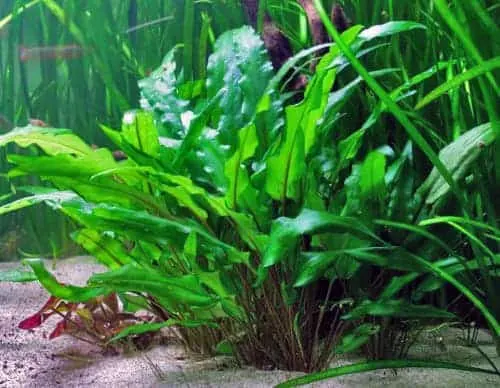
| Common name: | Crypt. Wendtii |
| Scientific name: | Cryptocoryne Wendtii |
| Max height: | 6 in / 15 cm |
| Care complexity: | Easy |
| Lighting needs: | Low to Moderate |
| Growth rate: | Slow |
| Additional CO2 required: | No |
| Recommended position: | Foreground / Midground plant |
| Fertilization: | Root tabs |
| Availability: | Buy on Amazon |
Cryptocoryne is popular in planted aquariums lined with gravel but also does great in sand.
The nice thing about this plant is that it comes in a few different colors. So you won’t be limiting yourself to green plants. There is also a red crypt. wendtii variation!
If you are curious about what plants grow well in sand, check out this article on my site!
Care is fairly simple for the C. Wendtii. It’s a strong plant that likes many water conditions. Low lighting is preferred by this plant, and it can live in a range of pH levels as well. It’s a great plant for discus fish too, not to mention that it helps keep ammonia and nitrates in check too!
As long as the pH is steady.
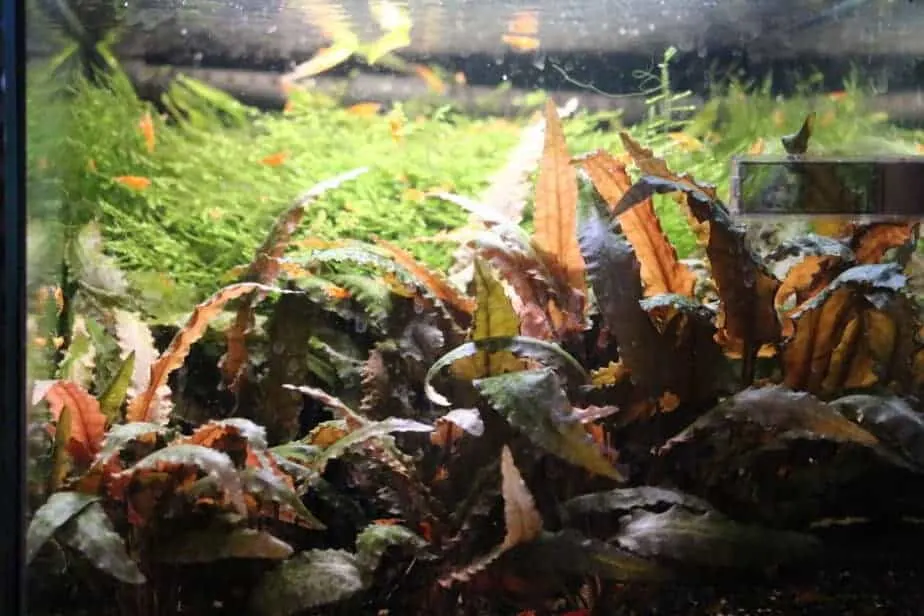
While this is an undemanding plant, you will need to root it down as soon as you can. Wendtii plants form large root systems, so gravel is an ideal substrate choice for the species.
Make sure the roots are firmly placed, and make sure you have plenty of gravel set into your tank. At least three inches!
This is one of the plants for which I would recommend adding root tabs.
From my personal experience, I can tell you that crypts do way better after adding a root tab. If you don’t have any yet, check out these root tabs from API on Amazon.
4. Java fern
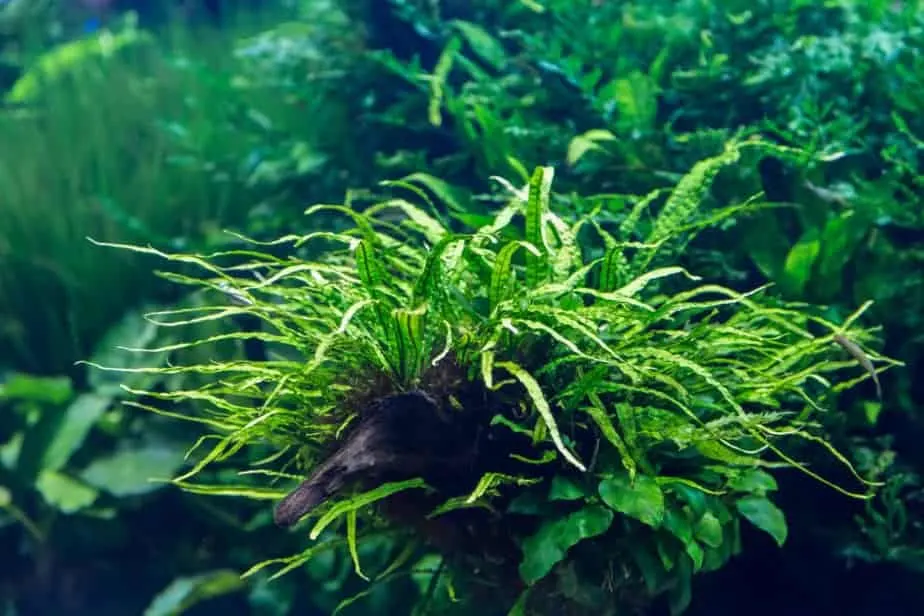
| Common name: | Java Fern |
| Scientific name: | Microsorum Pteropus |
| Max height: | 13.5 in / 35 cm |
| Care complexity: | Easy |
| Lighting needs: | Low |
| Growth rate: | Slow |
| Additional CO2 required: | No |
| Recommended position: | Midground / Background plant |
| Fertilization: | Liquid fertilizer |
| Availability: | Buy on Amazon |
Java Fern is another great option for new plant owners. Ferns grow well in gravel and require low levels of fertilizer to thrive.
You can grow many of these in your tank with a fairly low level of maintenance.
This is because Java fern adapts to almost any type of environment. They like very low concentrations of light and grow in a range of temperatures.
Your fish will also enjoy having these plants in their tank environment. The leaves of the Fern are big and provide plenty of coverage for all types of pets.
Java Fern doesn’t grow super-fast, but over time you can have a whole tank full of these full flora.
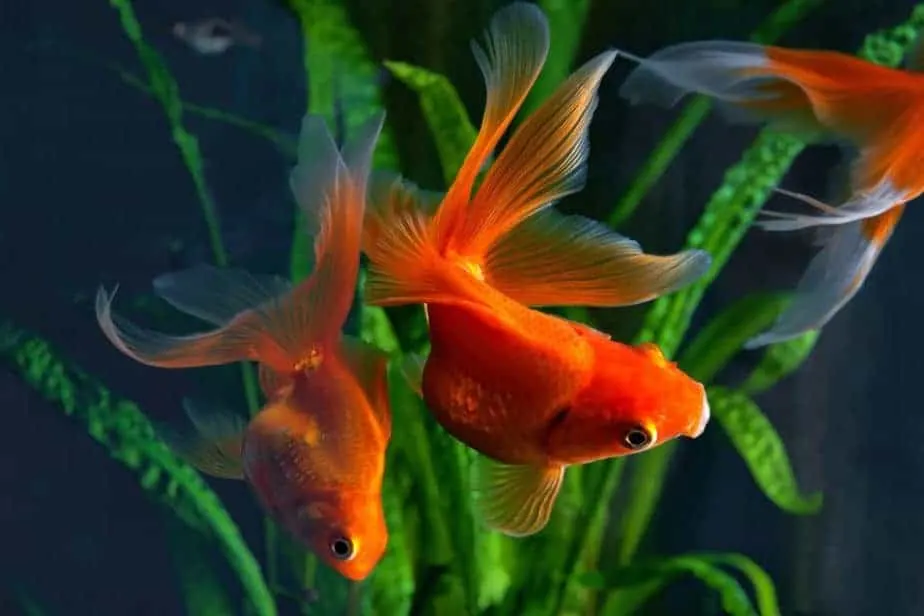
Again, there isn’t much to worry about in terms of care. Simply prune this plant and get rid of any plant waste.
Also consider the lighting, too much light can kill Java Fern. And in terms of gravel, don’t put the roots of the fern too deep into your substrate.
Gravel is a great way to root these plants down. But if you put this plant in too deeply it will die. Smaller gravel with some fertilizer will create the best plant growth.
5. Red Tiger Lotus
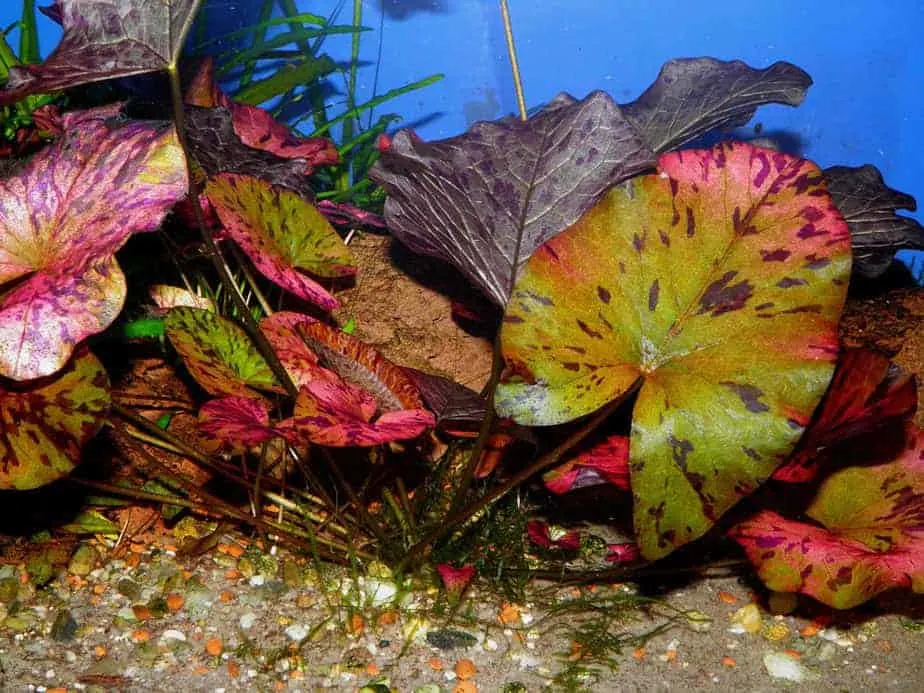
| Common name: | Red Tiger Lotus, Dwarf Lilly |
| Scientific name: | Nymphaea Zenkeri |
| Max height: | 20+ in / 50+ cm (under ideal circumstances) |
| Care complexity: | Moderate |
| Lighting needs: | Moderate to High |
| Growth rate: | Moderate to Fast |
| Additional CO2 required: | Yes (but can be done without) |
| Recommended position: | Midground / Background plant |
| Fertilization: | Root tabs and Liquid fertilizer |
| Availability: | Buy on Amazon |
Red Tiger Lotus is a popular flowering plant, but it can also grow in gravel.
If you choose to grow it underwater and grounded, you won’t see flowers form. Still, you will get a good visual from this plant species.
Tiger Lotus are not difficult plants, but you need to plant them correctly for the best results.
Make sure to get the roots buried in gravel, but do not cover the bulb of this plant. Otherwise, your Tiger will not grow right.
Furthermore, make sure your gravel is infused with plenty of fertilizer. This species needs a lot of nutrients to live in your aquarium.
Root tabs or aquarium soil is perfect.
Warmer climates are preferred by this plant, and medium levels of light should be used. More importantly, make sure to trim this plant, because it grows rapidly if left unattended!
6. Anubias
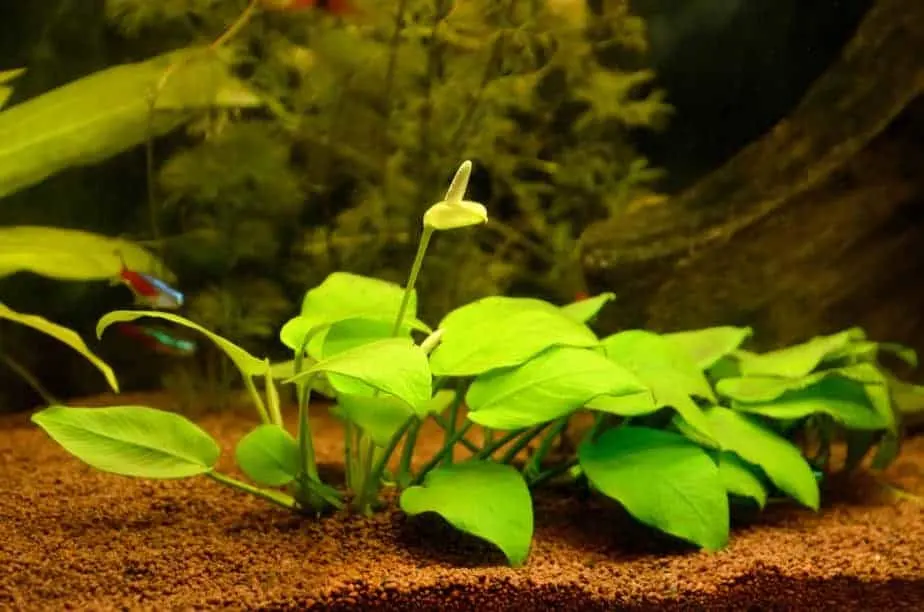
| Common name: | Anubias |
| Scientific name: | Anubias Barteri |
| Max height: | 16 inches / 40 cm |
| Care complexity: | Easy |
| Lighting needs: | Low |
| Growth rate: | Slow |
| Additional CO2 required: | No |
| Recommended position: | Midground / Background plant |
| Fertilization: | Liquid Fertilizer |
| Availability: | Buy on Amazon |
Anubias are large plants that provide shade for a range of aquariums.
They don’t like to be buried too deep, if at all. This plant can grow in gravel if you give it the right care. Overall though, the Anubias is a hardy tank plant that has simple care requirements.
Medium-light works well for the Anubias, and I generally recommend it as a low-light option too.
Fertilizer is not a must with an Anubias, as it grows pretty well on its own.
You can consider adding some liquid fertilizer to the water. This will help Anubias grow on a complete diet.
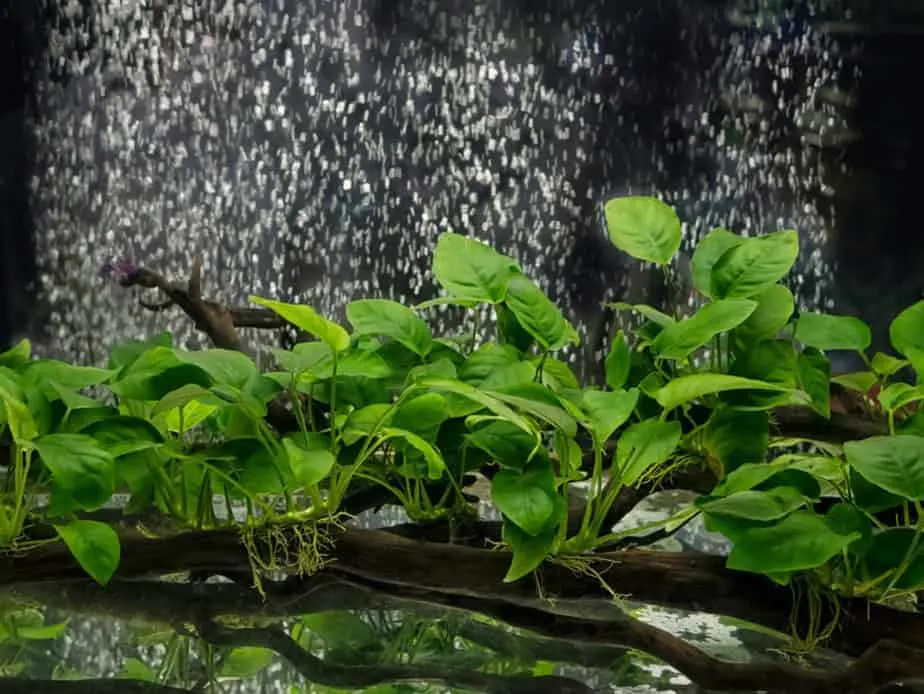
Instead of burying the roots in the gravel, Anubias plants prefer being attached to rocks and wood.
It is also on the list of plants that can grow without substrate. It is able to suck its nutrients straight out of the water.
7. Vallisneria
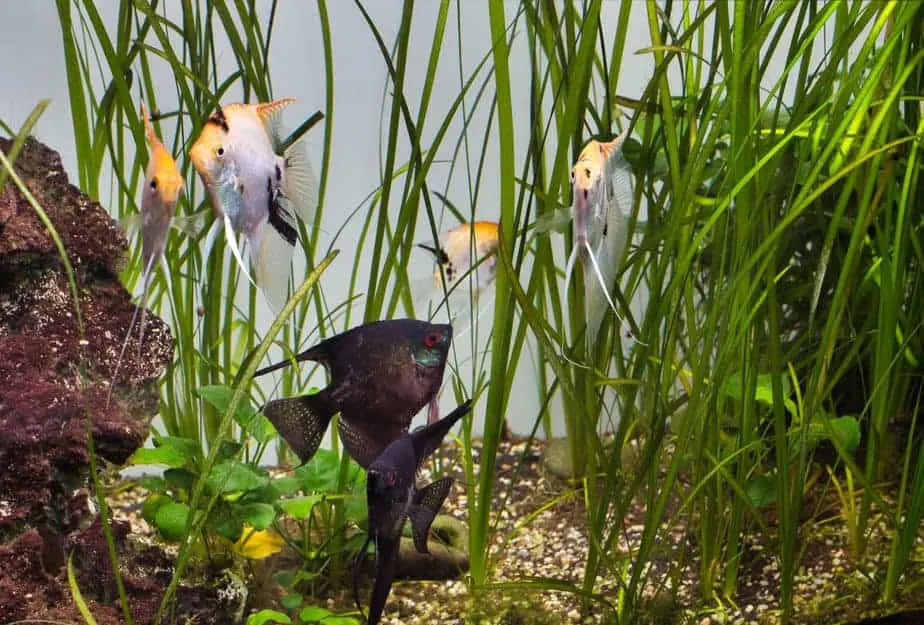
| Common name: | Vallisneria or Val |
| Scientific name: | Vallisneria Sp. |
| Max height: | 8 to 16+ inches / 20 to 40+ cm depending on the variety |
| Care complexity: | Easy |
| Lighting needs: | Moderate to High |
| Growth rate: | Moderate to Fast |
| Additional CO2 required: | Not necessary |
| Recommended position: | Background plant |
| Fertilization: | Root tabs |
| Availability: | Buy on Amazon |
Vallisneria is a fast-growing grass-type plant. It’s found in tropical conditions and prefers warmer water climates.
Vallisneria doesn’t require much to grow either, which makes it a great choice for bare aquariums that need more coverage.
You can plant this plant around the edges of your aquarium. It will form a nice backdrop for your tank.
Use it wisely to cover up blind spots or equipment such as filters and heaters.
Vallisneria grows tall and lush in a harder pH level. The temperature should be on the warmer side. And you will want to trim it to keep it from overtaking your tank.
Vallisneria can grow in gravel. The roots do not grow deep so just a small layer of gravel is fine.
8. Bucephalandra
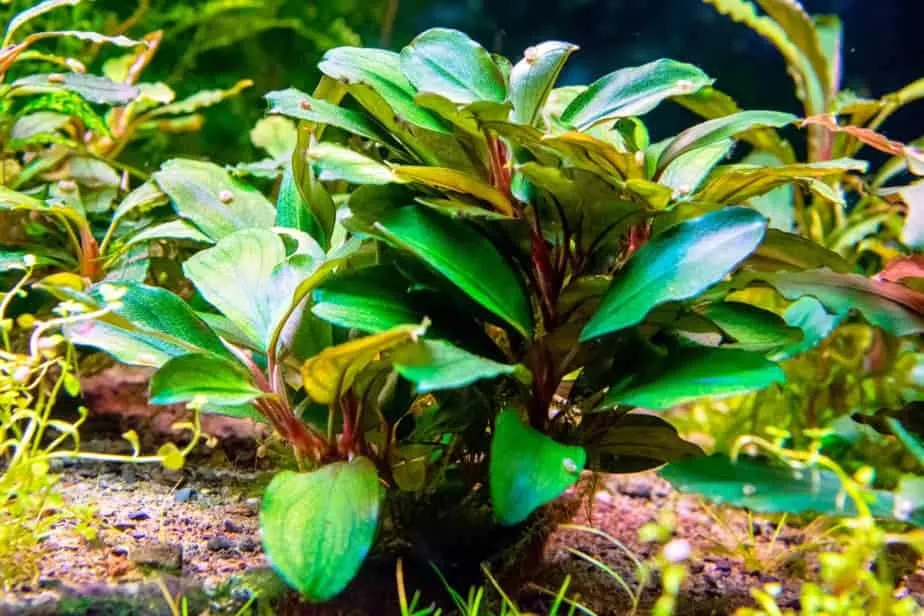
| Common name: | Bucephalandra |
| Scientific name: | Bucephalandra |
| Max height: | 4 in / 10 cm |
| Care complexity: | Easy |
| Lighting needs: | Low |
| Growth rate: | Slow |
| Additional CO2 required: | Not necessary |
| Recommended position: | Foreground / Midground plant |
| Fertilization: | Liquid fertilizer |
| Availability: | Buy on Amazon |
Unlike a lot of other plants on this list, Bucephalandra will need thicker gravel to grow. You don’t need massive rocks, but you do want something a little larger than normal gravel.
You can put Bucephalandra on top of your substrate, or bury it a little.
Just make sure that you don’t cover up the rhizome!
Porous gravel is preferred, this way the root system can grow strongly in its substrate and fully immerse itself.
You can also use other items to firmly keep your plant in place. In terms of other care tips, Bucephalandra grows slow in low light levels.
Water temperature should be at roughly 71 to 82 degrees.
In addition, you can get these plants in a few different colors. And with the right maintenance, they will grow large and become a centerpiece for your tank. This takes time, as it’s a slow growing plant.
9. Waterweeds (Anacharis elodea)
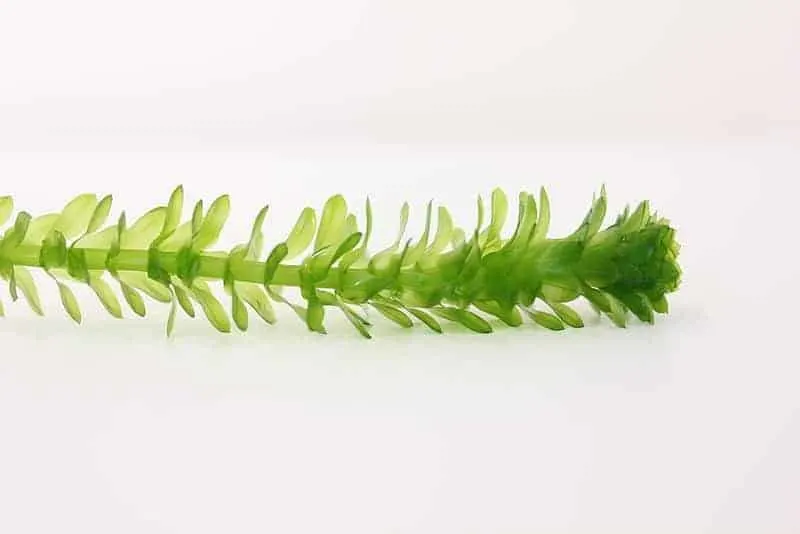
| Common name: | Brazilian Waterweeds |
| Scientific name: | Egeria densa |
| Max height: | Stem plants keep growing |
| Care complexity: | Easy |
| Lighting needs: | Medium to High |
| Growth rate: | Fast |
| Additional CO2 required: | Not necessary, but appreciated |
| Recommended position: | Background plant |
| Fertilization: | Liquid fertilizer |
| Availability: | Buy on Amazon |
Waterweeds are a South American plant. They are great at keeping tank water well oxygenated and filtered.
And like the other plants I mentioned, waterweed can withstand many water conditions and are not picky about water temperature.
For the best plant growth, try using medium-light to illuminate your plant.
Fertilizer can be used along with warmer water so that it reaches its full potential. But if you want to better control the size of your waterweed, colder water can slow its growth.
You can bury part of the stem plant in gravel to anchor it down. It will suck the nutrients straight out of the water. Therefore, root tabs are not necessary.
They should be placed at least 1-2 inches within your substrate.
A thick layer of gravel is not bad for this plant! Also, if you have multiple Waterweeds, make sure they are at least an inch apart. This way they can grow fully!
10. Dwarf Sagittaria
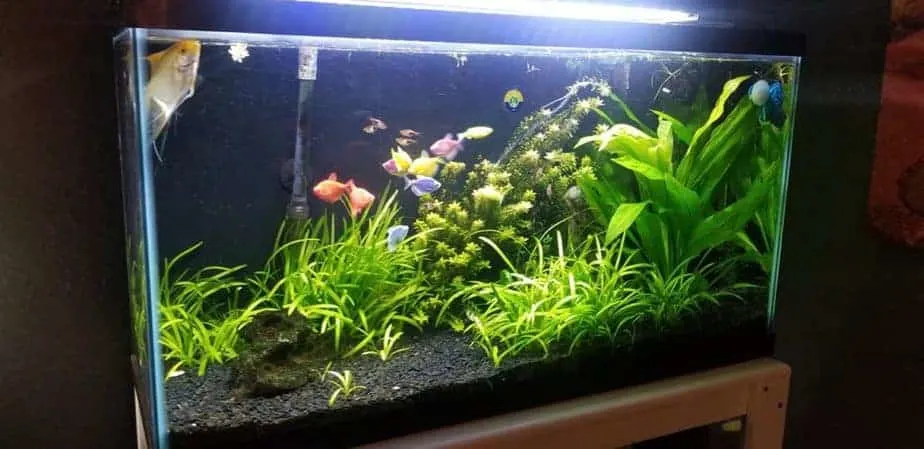
| Common name: | Dwarf Sagittaria |
| Scientific name: | Sagittaria subulata (Sagittaria pusilla) |
| Max height: | 6 in / 15 cm |
| Care complexity: | Easy |
| Lighting needs: | Medium |
| Growth rate: | Fast |
| Additional CO2 required: | Not necessary |
| Recommended position: | Foreground / Midground plant |
| Fertilization: | Root tabs |
| Availability: | Buy on Amazon |
The last plant on this list of gravel growers is the Dwarf Sagittaria.
If you are looking for a hardy and adaptable plant, this is one of the best options for your aquarium. Dwarf Sagittaria are typically found in America and Columbia, so they prefer more mild water temperatures.
They won’t have a difficult time in the water with a harder pH.
However, when you prepare to plant your Dwarf Sag, make sure you put plenty of nutrients in the gravel. For the best carpet I recommend using aqua-soil with nutrients.
These plants need a lot of fertilizer to grow. And if they don’t have iron they will wilt and die. When you plant your dwarf sag, plant it gently, but cover the roots.
A little bit of care is all this plant needs to thrive!
The Importance of Plant Gravel
Gravel is an adaptable medium that helps root plants and keeps them in place, and it’s useful for maintaining water parameters too. It’s a great addition to aquariums and can enhance the look of your water and aquatic greenery.
With all the varying looks and options available, you can easily find something that suits the style of your tank.
Gravel is important to keep a biological balance in the aquarium, as they host a colony of beneficial bacteria. For plants, the gravel is an anchor to keep them in place as well as a source for nutrients.
Finally, there are many different gravel varieties, which will improve the look of your tank!
Although cleaning gravel might sound like a chore, it does not have to be. Click here to find some of my tips to clean gravel with minimal amounts of effort.
Many people use gravel to finish off the look of their aquarium, and it looks really nice with a variety of mosses, such as java moss. Learn how to make a moss wall!
Making your tank match the natural environment of your fish is important. This not only allows your aquarium to look better but lets you construct a better home for your plants.
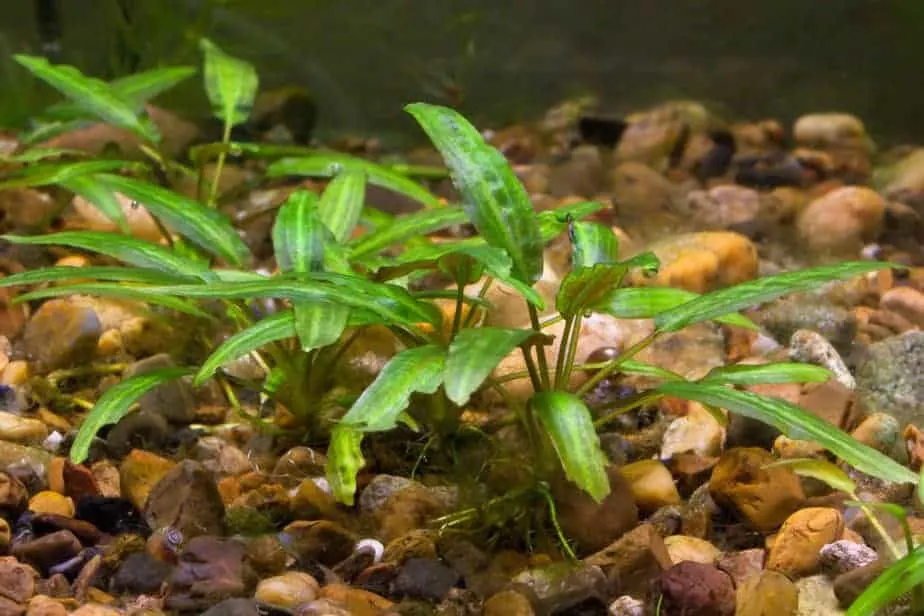
Gravel is especially important for rooting plants. Some plants can go without gravel or other substrates, but many will need something to hold them down.
While there are several materials available, gravel substrate is the perfect surface for a number of plant roots. The smoothness of gravel will help plants root firmly and properly.
Certain plants rely heavily on their roots for nutrients. These plants are often referred to as “root feeders”, and it can be hard for a beginner to recognize which plants belong to this group.
Therefore, I’ve written an article called “7 Aquarium Plants That Are Root Feeders and Need Root Tabs” which I recommend you check out. It’ll really help you growing plants in gravel.
For the most part, you don’t want greenery floating in the water. This could cause wilting or plant death. Most plants need roots to absorb nutrients into their cells.
Gravel allows rooting plants to grow properly and get the nutrition they need.
Gravel does not typically have nutrients in it. But you can add these in yourself with root tabs or fertilizer.
Choosing the Right Gravel for Your Aquarium
While gravel is crucial, you want to make sure to pick out the right gravel for your tank.
Do not buy just any gravel you see. Often, commercial gravel from a local tool store is too large for your fish tank.
You need a product that is made for fish and fish tanks to successfully root down plants!
The right gravel for an aquarium does not have any sharp ends, is bagged with as little dust as possible, and allows plant roots to grow a dense network.
The size, shape, and texture should be consistent, which often is the case for dedicated aquarium gravel. The color is up to personal preference.
There are some features to keep in mind as you make a purchase. But something you should remember is size and shape. The gravel for fish tanks should never be chunky or sharp.
Many fish like to rest at the bottom of their tanks.
You need gravel that is small and smooth in order to keep your fish safe.
Large sharp gravel is also a poor choice for plants. It won’t give your plant’s roots enough space to spread out. Consider this as well.
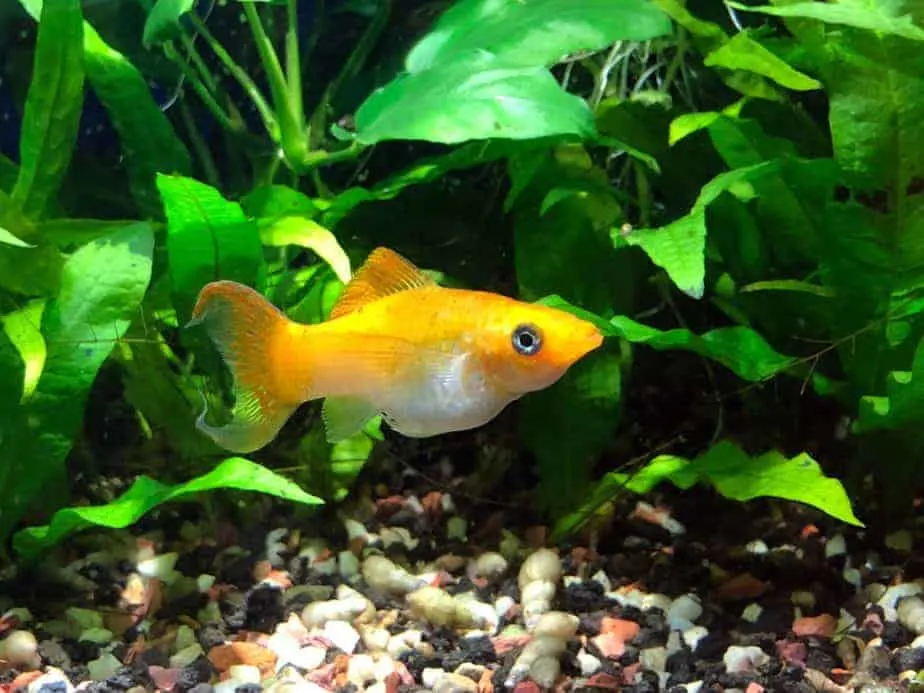
Once you find good-sized gravel, there are plenty of buying options. These small rocks come in several shapes, sizes, and colors.
The tone of your gravel isn’t important in terms of quality. You should choose something that fits with the theme of your tank setup.
A more earthy tone will look nice in a natural-looking tank.
More colorful or neon colors can work if you are going for an eye-popping aquarium space.
The shape is also something else to think about. Some gravels are more rounded while other gravels can be a little on the rough side.
You can also find bigger gravels and fine gravels. I recommend going for fine gravel for the best planting results. Around 3-8 mm is an ideal size for plant growth.
Putting Your Plants in Gravel
The amount of gravel you need in your planted aquarium depends on a few considerations. One thing to think about is tank size. With a larger aquarium, you will have to purchase more gravel.
Gravel usually goes in before your plant. And the correct amount needs to be put in to make plants root.
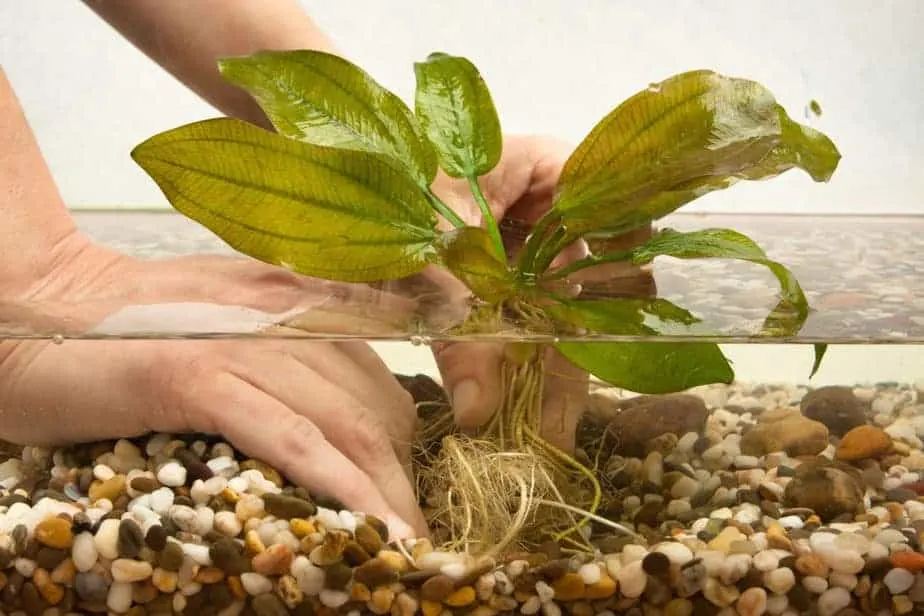
Normal tanks without plants only need an inch (3 cm) of gravel. But if you plan on having plants in your tank you need a lot more.
Three inches (10 cm) of gravel is a general rule of thumb.
A little bit of research might be necessary. Not all plants have the same substrate needs. Plants that need to root deeply will require more gravel. Other plants do not like to be buried in a ton of gravel.
In addition, make sure to keep your gravel clean.
Aquarium gravel has a tendency to get dirty. And if you want to ensure that your plants stay healthy you need to maintain it.
Obviously, more gravel will make this cleaning process longer, but it is a necessary step.
To learn all about cleaning gravel in an aquarium, check out the page. It is called: “How To Clean Fish Tank Gravel in 3 Easy Steps (Low Effort)“. This shows you easy and convenient ways to keep your substrate clean.
And make sure to do some light rinsing before you put gravel in your tank. Warm water should be used but don’t wash it with cleaning products!
You can also use an aquarium vacuum to clean down substrate once it is established in your tank.

